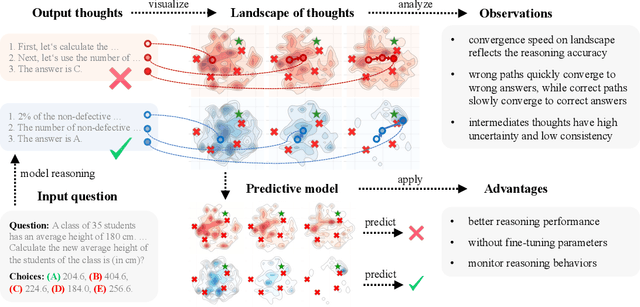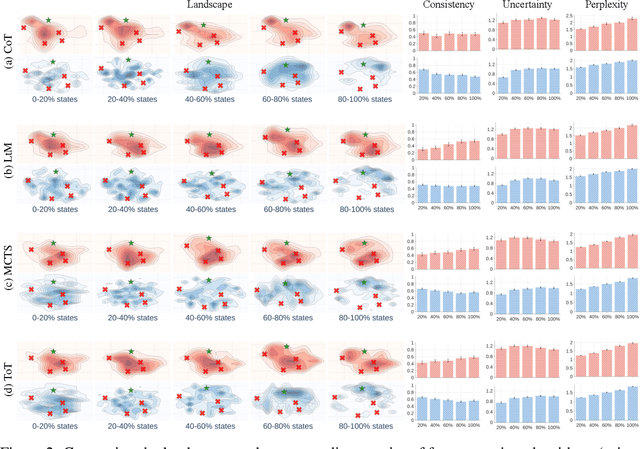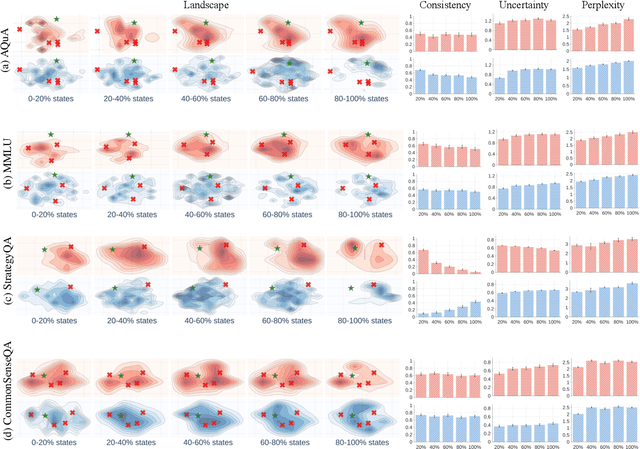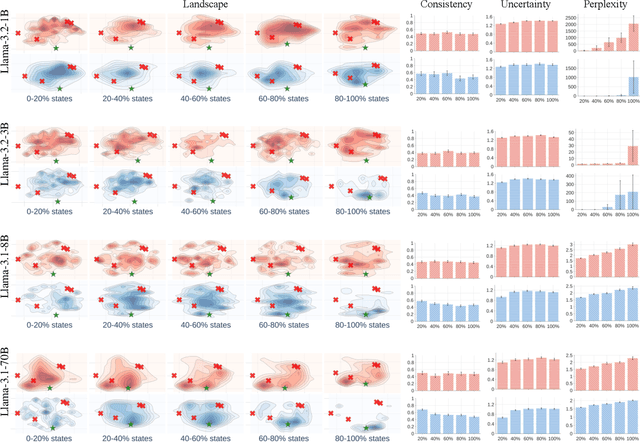Xuan Li
DeCoT: Decomposing Complex Instructions for Enhanced Text-to-Image Generation with Large Language Models
Aug 17, 2025Abstract:Despite remarkable advancements, current Text-to-Image (T2I) models struggle with complex, long-form textual instructions, frequently failing to accurately render intricate details, spatial relationships, or specific constraints. This limitation is highlighted by benchmarks such as LongBench-T2I, which reveal deficiencies in handling composition, specific text, and fine textures. To address this, we propose DeCoT (Decomposition-CoT), a novel framework that leverages Large Language Models (LLMs) to significantly enhance T2I models' understanding and execution of complex instructions. DeCoT operates in two core stages: first, Complex Instruction Decomposition and Semantic Enhancement, where an LLM breaks down raw instructions into structured, actionable semantic units and clarifies ambiguities; second, Multi-Stage Prompt Integration and Adaptive Generation, which transforms these units into a hierarchical or optimized single prompt tailored for existing T2I models. Extensive experiments on the LongBench-T2I dataset demonstrate that DeCoT consistently and substantially improves the performance of leading T2I models across all evaluated dimensions, particularly in challenging aspects like "Text" and "Composition". Quantitative results, validated by multiple MLLM evaluators (Gemini-2.0-Flash and InternVL3-78B), show that DeCoT, when integrated with Infinity-8B, achieves an average score of 3.52, outperforming the baseline Infinity-8B (3.44). Ablation studies confirm the critical contribution of each DeCoT component and the importance of sophisticated LLM prompting. Furthermore, human evaluations corroborate these findings, indicating superior perceptual quality and instruction fidelity. DeCoT effectively bridges the gap between high-level user intent and T2I model requirements, leading to more faithful and accurate image generation.
From Surface to Semantics: Semantic Structure Parsing for Table-Centric Document Analysis
Aug 14, 2025Abstract:Documents are core carriers of information and knowl-edge, with broad applications in finance, healthcare, and scientific research. Tables, as the main medium for structured data, encapsulate key information and are among the most critical document components. Existing studies largely focus on surface-level tasks such as layout analysis, table detection, and data extraction, lacking deep semantic parsing of tables and their contextual associations. This limits advanced tasks like cross-paragraph data interpretation and context-consistent analysis. To address this, we propose DOTABLER, a table-centric semantic document parsing framework designed to uncover deep semantic links between tables and their context. DOTABLER leverages a custom dataset and domain-specific fine-tuning of pre-trained models, integrating a complete parsing pipeline to identify context segments semantically tied to tables. Built on this semantic understanding, DOTABLER implements two core functionalities: table-centric document structure parsing and domain-specific table retrieval, delivering comprehensive table-anchored semantic analysis and precise extraction of semantically relevant tables. Evaluated on nearly 4,000 pages with over 1,000 tables from real-world PDFs, DOTABLER achieves over 90% Precision and F1 scores, demonstrating superior performance in table-context semantic analysis and deep document parsing compared to advanced models such as GPT-4o.
Efficient Part-level 3D Object Generation via Dual Volume Packing
Jun 11, 2025Abstract:Recent progress in 3D object generation has greatly improved both the quality and efficiency. However, most existing methods generate a single mesh with all parts fused together, which limits the ability to edit or manipulate individual parts. A key challenge is that different objects may have a varying number of parts. To address this, we propose a new end-to-end framework for part-level 3D object generation. Given a single input image, our method generates high-quality 3D objects with an arbitrary number of complete and semantically meaningful parts. We introduce a dual volume packing strategy that organizes all parts into two complementary volumes, allowing for the creation of complete and interleaved parts that assemble into the final object. Experiments show that our model achieves better quality, diversity, and generalization than previous image-based part-level generation methods.
CXR-AD: Component X-ray Image Dataset for Industrial Anomaly Detection
May 06, 2025



Abstract:Internal defect detection constitutes a critical process in ensuring component quality, for which anomaly detection serves as an effective solution. However, existing anomaly detection datasets predominantly focus on surface defects in visible-light images, lacking publicly available X-ray datasets targeting internal defects in components. To address this gap, we construct the first publicly accessible component X-ray anomaly detection (CXR-AD) dataset, comprising real-world X-ray images. The dataset covers five industrial component categories, including 653 normal samples and 561 defect samples with precise pixel-level mask annotations. We systematically analyze the dataset characteristics and identify three major technical challenges: (1) strong coupling between complex internal structures and defect regions, (2) inherent low contrast and high noise interference in X-ray imaging, and (3) significant variations in defect scales and morphologies. To evaluate dataset complexity, we benchmark three state-of-the-art anomaly detection frameworks (feature-based, reconstruction-based, and zero-shot learning methods). Experimental results demonstrate a 29.78% average performance degradation on CXR-AD compared to MVTec AD, highlighting the limitations of current algorithms in handling internal defect detection tasks. To the best of our knowledge, CXR-AD represents the first publicly available X-ray dataset for component anomaly detection, providing a real-world industrial benchmark to advance algorithm development and enhance precision in internal defect inspection technologies.
Anti-adversarial Learning: Desensitizing Prompts for Large Language Models
Apr 25, 2025Abstract:With the widespread use of LLMs, preserving privacy in user prompts has become crucial, as prompts risk exposing privacy and sensitive data to the cloud LLMs. Traditional techniques like homomorphic encryption, secure multi-party computation, and federated learning face challenges due to heavy computational costs and user participation requirements, limiting their applicability in LLM scenarios. In this paper, we propose PromptObfus, a novel method for desensitizing LLM prompts. The core idea of PromptObfus is "anti-adversarial" learning, which perturbs privacy words in the prompt to obscure sensitive information while retaining the stability of model predictions. Specifically, PromptObfus frames prompt desensitization as a masked language modeling task, replacing privacy-sensitive terms with a [MASK] token. A desensitization model is trained to generate candidate replacements for each masked position. These candidates are subsequently selected based on gradient feedback from a surrogate model, ensuring minimal disruption to the task output. We demonstrate the effectiveness of our approach on three NLP tasks. Results show that PromptObfus effectively prevents privacy inference from remote LLMs while preserving task performance.
Articulated Kinematics Distillation from Video Diffusion Models
Apr 01, 2025Abstract:We present Articulated Kinematics Distillation (AKD), a framework for generating high-fidelity character animations by merging the strengths of skeleton-based animation and modern generative models. AKD uses a skeleton-based representation for rigged 3D assets, drastically reducing the Degrees of Freedom (DoFs) by focusing on joint-level control, which allows for efficient, consistent motion synthesis. Through Score Distillation Sampling (SDS) with pre-trained video diffusion models, AKD distills complex, articulated motions while maintaining structural integrity, overcoming challenges faced by 4D neural deformation fields in preserving shape consistency. This approach is naturally compatible with physics-based simulation, ensuring physically plausible interactions. Experiments show that AKD achieves superior 3D consistency and motion quality compared with existing works on text-to-4D generation. Project page: https://research.nvidia.com/labs/dir/akd/
Landscape of Thoughts: Visualizing the Reasoning Process of Large Language Models
Mar 28, 2025



Abstract:Numerous applications of large language models (LLMs) rely on their ability to perform step-by-step reasoning. However, the reasoning behavior of LLMs remains poorly understood, posing challenges to research, development, and safety. To address this gap, we introduce landscape of thoughts-the first visualization tool for users to inspect the reasoning paths of chain-of-thought and its derivatives on any multi-choice dataset. Specifically, we represent the states in a reasoning path as feature vectors that quantify their distances to all answer choices. These features are then visualized in two-dimensional plots using t-SNE. Qualitative and quantitative analysis with the landscape of thoughts effectively distinguishes between strong and weak models, correct and incorrect answers, as well as different reasoning tasks. It also uncovers undesirable reasoning patterns, such as low consistency and high uncertainty. Additionally, users can adapt our tool to a model that predicts the property they observe. We showcase this advantage by adapting our tool to a lightweight verifier that evaluates the correctness of reasoning paths. The code is publicly available at: https://github.com/tmlr-group/landscape-of-thoughts.
Unsupervised Detection of Fraudulent Transactions in E-commerce Using Contrastive Learning
Mar 24, 2025Abstract:With the rapid development of e-commerce, e-commerce platforms are facing an increasing number of fraud threats. Effectively identifying and preventing these fraudulent activities has become a critical research problem. Traditional fraud detection methods typically rely on supervised learning, which requires large amounts of labeled data. However, such data is often difficult to obtain, and the continuous evolution of fraudulent activities further reduces the adaptability and effectiveness of traditional methods. To address this issue, this study proposes an unsupervised e-commerce fraud detection algorithm based on SimCLR. The algorithm leverages the contrastive learning framework to effectively detect fraud by learning the underlying representations of transaction data in an unlabeled setting. Experimental results on the eBay platform dataset show that the proposed algorithm outperforms traditional unsupervised methods such as K-means, Isolation Forest, and Autoencoders in terms of accuracy, precision, recall, and F1 score, demonstrating strong fraud detection capabilities. The results confirm that the SimCLR-based unsupervised fraud detection method has broad application prospects in e-commerce platform security, improving both detection accuracy and robustness. In the future, with the increasing scale and diversity of datasets, the model's performance will continue to improve, and it could be integrated with real-time monitoring systems to provide more efficient security for e-commerce platforms.
Cosmos-Reason1: From Physical Common Sense To Embodied Reasoning
Mar 18, 2025Abstract:Physical AI systems need to perceive, understand, and perform complex actions in the physical world. In this paper, we present the Cosmos-Reason1 models that can understand the physical world and generate appropriate embodied decisions (e.g., next step action) in natural language through long chain-of-thought reasoning processes. We begin by defining key capabilities for Physical AI reasoning, with a focus on physical common sense and embodied reasoning. To represent physical common sense, we use a hierarchical ontology that captures fundamental knowledge about space, time, and physics. For embodied reasoning, we rely on a two-dimensional ontology that generalizes across different physical embodiments. Building on these capabilities, we develop two multimodal large language models, Cosmos-Reason1-8B and Cosmos-Reason1-56B. We curate data and train our models in four stages: vision pre-training, general supervised fine-tuning (SFT), Physical AI SFT, and Physical AI reinforcement learning (RL) as the post-training. To evaluate our models, we build comprehensive benchmarks for physical common sense and embodied reasoning according to our ontologies. Evaluation results show that Physical AI SFT and reinforcement learning bring significant improvements. To facilitate the development of Physical AI, we will make our code and pre-trained models available under the NVIDIA Open Model License at https://github.com/nvidia-cosmos/cosmos-reason1.
Optimized Unet with Attention Mechanism for Multi-Scale Semantic Segmentation
Feb 06, 2025



Abstract:Semantic segmentation is one of the core tasks in the field of computer vision, and its goal is to accurately classify each pixel in an image. The traditional Unet model achieves efficient feature extraction and fusion through an encoder-decoder structure, but it still has certain limitations when dealing with complex backgrounds, long-distance dependencies, and multi-scale targets. To this end, this paper proposes an improved Unet model combined with an attention mechanism, introduces channel attention and spatial attention modules, enhances the model's ability to focus on important features, and optimizes skip connections through a multi-scale feature fusion strategy, thereby improving the combination of global semantic information and fine-grained features. The experiment is based on the Cityscapes dataset and compared with classic models such as FCN, SegNet, DeepLabv3+, and PSPNet. The improved model performs well in terms of mIoU and pixel accuracy (PA), reaching 76.5% and 95.3% respectively. The experimental results verify the superiority of this method in dealing with complex scenes and blurred target boundaries. In addition, this paper discusses the potential of the improved model in practical applications and future expansion directions, indicating that it has broad application value in fields such as autonomous driving, remote sensing image analysis, and medical image processing.
 Add to Chrome
Add to Chrome Add to Firefox
Add to Firefox Add to Edge
Add to Edge